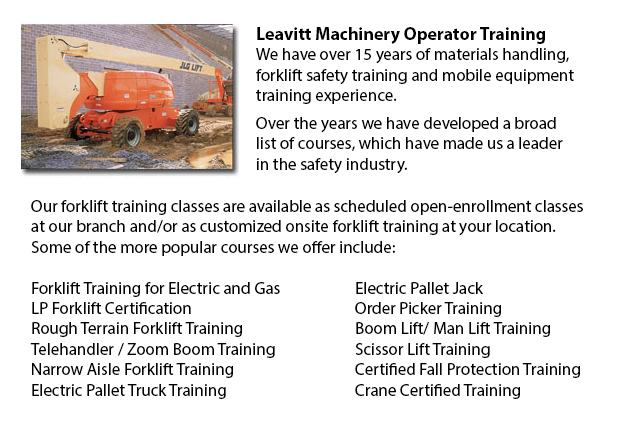
Manlift Training Brampton - There are lots of manlift training courses that offer a review of the manlift machinery. The practicum portion of the training is another important part of the program. In this part the trainee has chance to demonstrate their practical abilities, their ability to operate the manlift safely. A prerequisite to Manlift training is the fall protection training, which can be included in the training according to the specific needs of the client.
Course Content
The course content consists of: pre-shift equipment inspection and work area survey requirements; the impact of doing unsafe acts or utilizing unsafe machinery, Review of load capacities, Lifting devise machine definitions, safety decals and particular machine requirements, Review of related sections of the OSHA Standards as well as the CSA Standards and Review site specific Dangers, along with controls for safe use of a lifting device.
Demonstration and Evaluation Content
Demonstration and evaluation content comprises: making use of a signaler or a spotter when needed; Proper personal protective equipment or also referred to as P.P.E. as required; Operating a lift just on solid and level ground; Using the right fitting harness or fall arrest device; Operating the lift with all other employees clear of the job place; Aware of load limitations etc. and other specs as set out by the manufacturer; Pre-shift work area survey and equipment inspection; Having all associated equipment stored safely on the lift platform; Ensuring a smooth and safe operating speed for various plant conditions and isolating off the work area when major work projects are to be finished.
Each person would be tested to make certain they could efficiently and safely operate your site-specific machine.
Manlift Safety
As the manlift is capable of lifting personnel and materials over 20 feet in the air, these equipment pose a particular amount of risk and can be dangerous machines if not used correctly. Because the danger is so apparent, lift owners and operators are careful to correctly maintain their machines and follow correct safety precautions and operating procedures. The ratio of accidents involving this specific machine is quite low.
The safety specifications for boom lifts and scissor lifts puts the burden for safe manlift operation on the user. You are responsible for understanding how to safely operate the lift even if you only lease the machinery for a day. The most basic safety features on the machine are safety decals and the operating manual. These show vital information regarding the operating procedures, safety machines and maintenance.
Newer lift models will come with manuals and decals in place. Technically, the operating manual should be stored on the lift itself. If you are purchasing a second-hand lift, it is essential to ensure that the handbook is included and that essential decals haven't been painted over. The restraints that prevent operators from falling and the guardrails are other vital safety features. These are standard and mandatory on all types of lifts.
-
Boom Lift Operator Training Brampton
Boom Lift Operator Training Brampton - A cherry picker is a type of aerial work platform. Cherry pickers consist of a platform or bucket at the hydraulic lifting system's end. The device is also called a man lift, boom lift, basket crane or hydraladd... More -
Forklift Instructor Training Brampton
Forklift Instructor Training Brampton - For those lift truck operators who want to become a forklift instructor it is recommended that they complete a forklift Instructor training certification program. Entry qualifications for the forklift instructo... More -
Manlift Certification Brampton
Manlift Certification Brampton - The Manlifts and Elevated Platforms program offers training on the regulations, rules and correct application of safe operating measures and work practices involved in daily activities for those who work using this ma... More -
Telehandler Training in Brampton
Telescopic handlers normally called telehandlers for short, are a really popular piece of heavy construction equipment. They are usually used in the construction and agricultural trades. These machines have farthest reaching capacity and are able to... More -
Order Picker Training Brampton
Order Picker Training Brampton - The order picker lift truck allows for people working in a warehouse setting to lift pallets making use of forks. This electronically-powered machinery is also referred to as a stock picker and is similar to a forklif... More -
Zoom Boom Ticket Brampton
Zoom Boom Ticket Brampton - Zoom Boom Training focuses on correctly training prospective operators on variable reach forklifts. The training objectives include gaining the knowledge of the equipments physics and to be able to define the tasks of the... More -
Crane Training Schools Brampton
Crane Training Schools Brampton - Our different Mobile Crane Operation programs are meant for experienced operators who requires re-certification or certification, and for inexperienced people who are searching for their first job as a crane operator... More -
Crane Safety Training Brampton
Crane Safety Training Brampton - Both crane operator as well as their employers need to be aware of all the potential problems associated to the use of an overhead crane. All across North America, there is legislation which provides rules for the saf... More

Forklift Training Brampton
TOLL FREE: 1-888-254-6157
Brampton, Ontario
forklifttrainingbrampton.ca
Email Us
About Us


